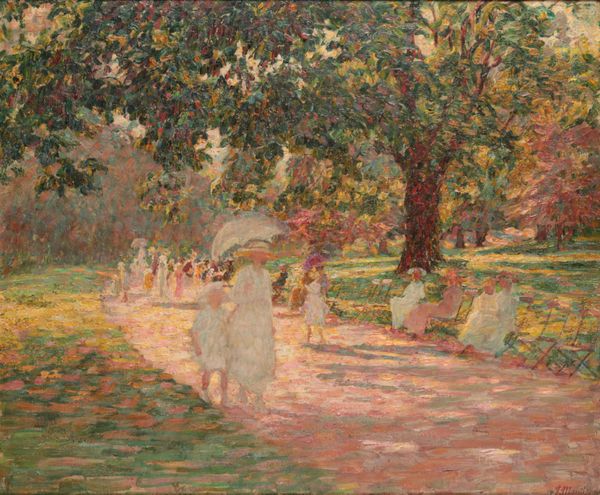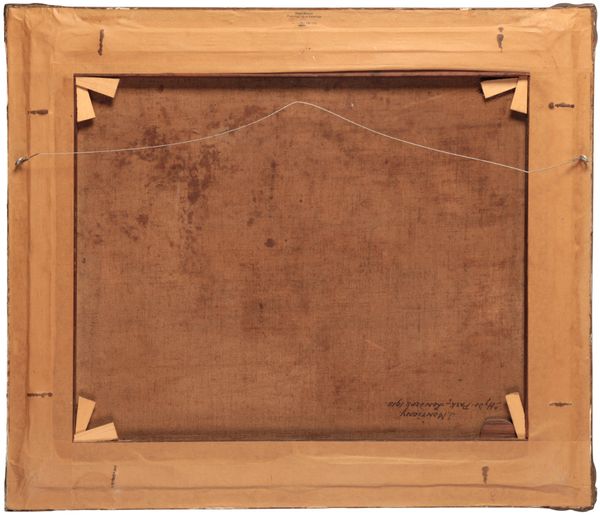Woman and children enjoying a bright day, signed lower right, further signed, dated and titled verso,
oil on canvas, 50cm x 60cm
Provenance: The Collection of the Artist
The Collection of Louis Montigny, the brother of the Artist and his wife Lilian Attneave
and thence by descent.
Note: The area of Hyde Park depicted in this work is known as ‘Rotten Row’, a fashionable place for upper-class Londoners to be seen from the 17th century onwards.
| Condition Report: | click here |
| Estimate: | £10,000 - £20,000 |
| Hammer price: | £34,000 |
Jenny Montigny
A pioneering female impressionist, Jenny Montigny was a founding member of the luminist group of Belgian artists ‘Vie et Lumière’.
Born in Ghent where her father was a law professor at the city’s university, Montigny’s early interest in art was fuelled by an early encounter with ‘The Kingfishers’ by Emile Claus (1849-1924) housed in the Museum of Fine Art (MSK) in Ghent. This pivotal experience led her to take private lessons with Claus at his country home Villa Zonneschijn in 1893. Despite the fact that Claus was married and twenty-six years her senior, they began a relationship that lasted until his death in 1924.
Unsupported by her parents, who disapproved of her artistic interests, Montigny dared to be independent, and settled at Villa Rustoord in nearby Deurle in 1904. While a number of other female artists emerged at this time, notably Anna de Weert (née Cogen), Montigny was unique in living on her own, with neither a husband nor her parents.
At the outbreak of World War I, she fled to London, where her brother Louis Montigny was living with his wife, Lillian Attneave. Claus and his wife Charlotte Dufaux also came to London and it is often insinuated that Jenny deliberately followed Claus, but in reality Claus only stayed in the capital for a few weeks before travelling to Wales. On 5th November 1914 Claus wrote to Cyriel Buysse in The Hague that he had left London. “I’ve run away from London: too many refugees of all kinds.” In the same letter, Claus asked about the whereabouts of friends and acquaintances, including that of ‘J.M.’. It is clear that in the first chaotic period of the war, Claus and his pupil had no contact and no idea about each other’s whereabouts. Artistically, Montigny flourished during her time in London. She exhibited in several London galleries, including the Dowdeswell Gallery, the Grafton Galleries and the New English Art Club. Her name appeared in many exhibitions for and by the Belgian artists in exile, well known all the way to Rotterdam. She joined the Women’s International Art Club, exhibiting with other artists such as Amy Katherine Browning (1881-1978) and Dorothea Sharp (1874-1955).
After the war, she returned to Belgium and, finding it necessary to sell her villa, moved into a more modest home. In 1923, she joined the Société Nationale des Beaux-Arts. After Claus’ death, she found herself in worsening financial straits. Her painting style was no longer popular and it was necessary to accept charity from family and friends. She was largely forgotten after her death until 1987, when exhibitions were held in Deurle and Deinze. In 1995, a major retrospective took place at the Musée Pissarro in Pontoise.
Jenny Montigny died of cancer on 31 October 1937, in her house in the Pontstraat in Deurle at half past one in the morning. As with so many female artists of the period, Montigny suffered from a lack of exposure due to being a woman, but in recent years her work has been enjoying renewed and deserved attention internationally. In 2019 the city of Ghent even named a street after her.
canvas unlined, small pinhole to the canvas lower left, otherwise no obvious signs of damage or restoration, work has probably been fairly recently cleaned, picture conservator details to the frame verso




